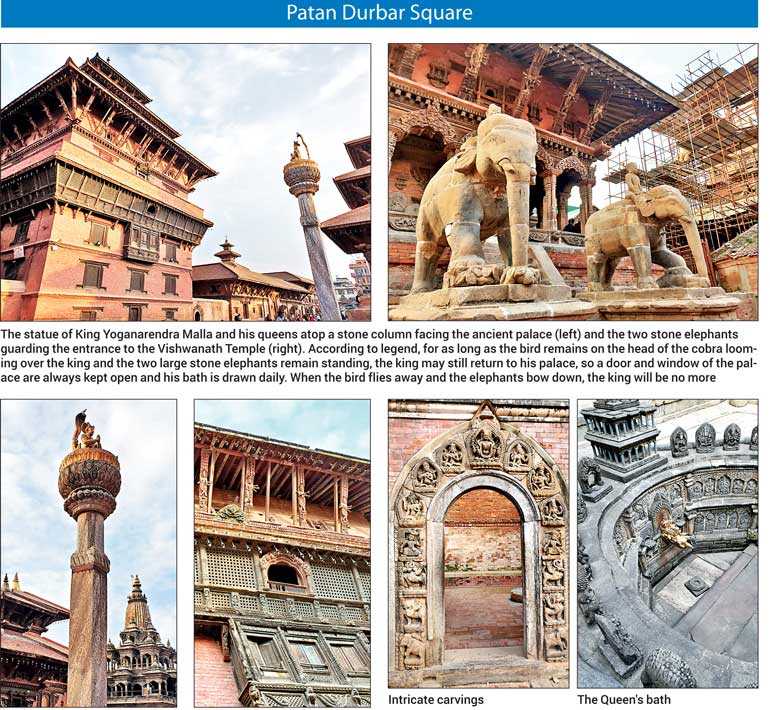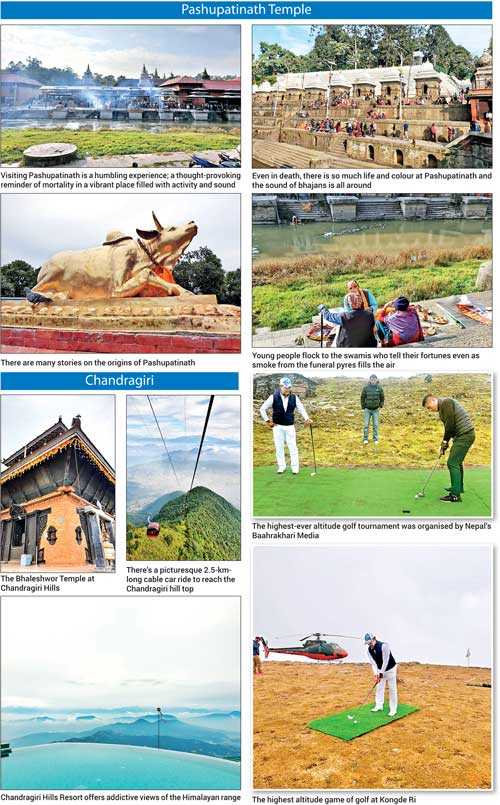Monday Mar 10, 2025
Monday Mar 10, 2025
Monday, 11 November 2019 00:00 - - {{hitsCtrl.values.hits}}

Part I
By Marianne David
It all began with golf. A golf tournament, in fact, and not just any old golf tournament – this was to be the highest-ever altitude golf tournament, to be played in the shadow of Mount Everest, in Kongde Ri.
Organised by Nepal’s Baahrakhari Media Ltd., the game was to be held in two phases – one in Kongde Ri with the participation of over 40 golfers and the other at Gokarna Golf Club in Gokarna, Kathmandu, with some 100 golfers.
Daily FT was among the international media invited for the event and reached Nepal on the evening of 19 October, with the tournament set to kick off in Kongde Ri on 20 October.
Having checked in at the Taj Vivanta and met the rest of the media team and the Baahrakhari Media personnel at cocktails and dinner hosted by Chaudhary Group Chairman Binod Chaudhary at the hotel, it was time to prepare for an early departure the next morning.
The highest-ever game of golf
The big day dawned, but the envisaged grand game was not to be. While the weather’s supposed to be close to perfect in October, this time the heavy cloud cover did not relent. Waiting time began, but even four hours later there was no respite and it was far too risky for the helicopters to fly to the location.
A handful of golfers managed a quick game at an altitude of 4,250 metres (13,943 feet) and set the record, but the bad weather dashed many expectations of the event, which was organised to boost tourism in Nepal. The four who made it to the one-hole golf course prepared just below the snow-line were the lucky ones, but only one managed to par the hole.
A second set of golfers teed off at another makeshift course in Syangboche, located at an altitude of 3,880 metres (12,730 feet), overlooking Mount Everest and other Himalayan peaks. The remainder of the tournament was played in Kathmandu on 26 October. 
According to Baahrakhari Media Editor-in-Chief Prateek Pradhan, the highest game of golf that had previously been played was at an altitude of 3,960 metres (12,992 feet) in the north-eastern Indian state of Sikkim.
For the rest of us, it was time to turn back by mid-morning and the media team headed off to Chandragiri Hills.
Chandragiri Hills
Located south-west of Kathmandu Valley and 2,551 metres above sea level, Chandragiri Hills offers addictive views of the Himalayan range from Annapurna to the Everest and the Kathmandu Valley, covered in lush greenery.
We took a picturesque 2.5-km-long cable car ride to reach the hill top and checked into the Chandragiri Hills Resort and revelled in the panoramic views, clicking endless pictures and praying for Mount Everest to show herself. The infinity pool here is a sight to remember, merging seamlessly with the sky and mountain peaks.
In the evening we visited the Bhaleshwor Temple, located a short walk away from the resort. A temple of Lord Shiva, the story behind it is as follows: “It is believed that Satidevi, Shiva’s consort, gave up her life by jumping into a fire pyre at her father Daksha Prajapati’s sacred fire ritual after Daksha insulted her husband Shiva in front of scores of other gods and goddesses. An enraged Shiva then carried her dead body on his back and walked across the world for a long time, without taking note of Satidevi’s decaying body. Different Shakti centres were established at sites where different parts of Satidevi’s body fell in the course of Lord Shiva’s mourning.”
The Bhaleshwor Temple is considered to be one of these sites.
Nepal in the news
Rested and rejuvenated, we headed back to Kathmandu in the morning. First up was a meeting with Chaudhary and Pradhan at Chaudhary House.
Addressing the media, Chaudhary asserted that although Nepal had frequently attracted the attention of the world for not-so-happy political reasons, it now needed to come out and be seen for good reasons.
“From earthquakes claiming lives to 25 governments in 26 years and the palace massacre, there has been a lot of bad news about Nepal. I am looking for good news about the country! Tremendous goodwill exists for Nepal, which remains a country that everybody in the world wants to visit at least once in their lifetime.”
“Tourism is our backbone and we have to take forward the right kind of message, which is how the highest altitude golf tournament effort came about,” added Chaudhary, commending Baahrakhari Media for the initiative.
Following a vegetarian lunch featuring traditional Nepalese dishes at Chaudhary House, it was time to visit the famed Pashupatinath Temple.
Pashupatinath Temple
Pashupatinath, which was included in the UNESCO World Heritage Sites list in 1979, is a sacred Hindu temple located on the banks of the Bagmati River comprising a sprawling complex of temples, ashrams and images which came into being over centuries.
The temple is dedicated to Pashupati, an incarnation of the Hindu God Shiva, as Lord of the Animals. There are many stories on the origins of the temple, revolving around Lord Shiva turning himself into a deer to explore the beautiful area and the wish-fulfilling cow Kamadhenu.
Visiting this temple is an utterly humbling experience; a thought-provoking reminder of mortality in a vibrant place filled with activity and sound. Be prepared for the bodies – being washed in the river, decorated with flowers, burned on the pyres.
Even in death, there is so much life and colour here and the sound of bhajans is all around. Young people flock to the swamis who tell their fortunes even as smoke from the funeral pyres fills the air and vendors do brisk business selling religious trinkets. This place is an awe-inspiring union of life and death.
Patan Durbar Square
We end the day with a visit to the Patan Durbar Square, where we are accosted by a guide we cannot shake off – and we don’t regret it, for he points out so much we would have otherwise missed.
One of the three Durbar Squares in the Kathmandu Valley, all of which are UNESCO World Heritage Sites, the Patan Square is located at the centre of the city of Lalitpur and considered one of the world’s oldest Buddhist cities.
A key attraction here is the ancient royal palace where the Malla Kings of Lalitpur resided. According to our guide, the palace was built with small doors through which only one person can enter at a time in order to hinder attacks by enemies and the doors are elevated so that ghosts, who are believed to glide along the ground, cannot enter.
The temples here feature striking and intricate carvings, including scenes from the Ramayana and Mahabharata.
The statues hold many stories and our guide related one about the statue of King Yoganarendra Malla and his queens atop a stone column facing the ancient palace that especially caught our interest. There is a cobra looming over the king’s head and on the head of the cobra is a small brass bird. Nearby, two large stone elephants guard the entrance to the Vishwanath Temple.
According to legend, for as long as the bird remains and the elephants stand, the king may still return to his palace, so a door and window of the palace are always kept open and his bath is drawn daily. When the bird flies away and the elephants bow down, the king will be no more.
‘Lifetime Experiences’
In the evening we attended a reception hosted by the Tourism Ministry. Welcoming the gathering, Nepali Minister for Culture, Tourism and Civil Aviation Yogesh Bhattarai said: “The Government has decided to celebrate 2020 as the year of tourism. I am confident that the initiative taken to play golf at the highest point on earth will be instrumental in promoting tourism and golf in Nepal.”
According to Nepal Tourism Board CEO Deepak Raj Joshi, close to 1.2 million arrivals were recorded in 2018 and the goal for 2020 is two million with the tourism boost themed ‘Lifetime Experiences’.
As the evening came to a close, we were told an attempt would be made to send a team of five journalists to Kongde Ri the next morning, given some signs of the weather relenting.
Exhilarated, five of us prepared for a ‘lifetime experience’. And Nepal – and Mount Everest – delivered in style.
(Next up: Nine days in Nepal – Part II.)
Discover Kapruka, the leading online shopping platform in Sri Lanka, where you can conveniently send Gifts and Flowers to your loved ones for any event including Valentine ’s Day. Explore a wide range of popular Shopping Categories on Kapruka, including Toys, Groceries, Electronics, Birthday Cakes, Fruits, Chocolates, Flower Bouquets, Clothing, Watches, Lingerie, Gift Sets and Jewellery. Also if you’re interested in selling with Kapruka, Partner Central by Kapruka is the best solution to start with. Moreover, through Kapruka Global Shop, you can also enjoy the convenience of purchasing products from renowned platforms like Amazon and eBay and have them delivered to Sri Lanka.
Discover Kapruka, the leading online shopping platform in Sri Lanka, where you can conveniently send Gifts and Flowers to your loved ones for any event including Valentine ’s Day. Explore a wide range of popular Shopping Categories on Kapruka, including Toys, Groceries, Electronics, Birthday Cakes, Fruits, Chocolates, Flower Bouquets, Clothing, Watches, Lingerie, Gift Sets and Jewellery. Also if you’re interested in selling with Kapruka, Partner Central by Kapruka is the best solution to start with. Moreover, through Kapruka Global Shop, you can also enjoy the convenience of purchasing products from renowned platforms like Amazon and eBay and have them delivered to Sri Lanka.